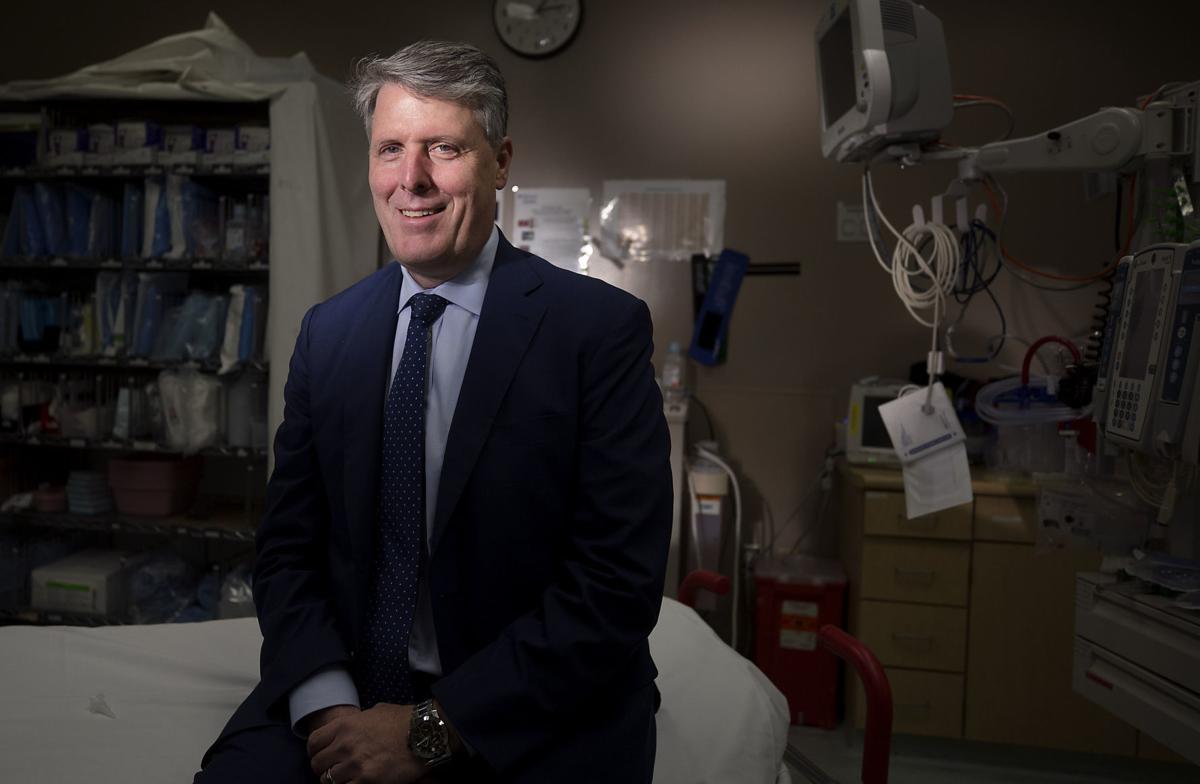Dr. Chad Whelan was named chief executive officer of Banner-University Medicine in Tucson on Sept. 26.
This includes both hospitals, Banner-University Medical Center Tucson and Banner-UMC South, as well as the Banner University Medical Group, comprised of physicians and other providers who are faculty members of the UA College of Medicine, clinics and the University Physicians Healthcare faculty practice plan.
He joined Banner-University Medicine in the midst of infrastructure expansion at the main Tucson hospital and at an innovative moment in health care. A new hospital tower is under construction at Banner-UMC and will replace the current hospital, which was built in 1971.
“Some of the infrastructure here is old,” Whelan said. “To provide the kind of care we want to provide, we need to update the facilities.”
It is a $400 million project for a new nine-story, 670,000-square-foot inpatient tower and 75,000- square-foot renovation of existing facilities. More than $50 million will go to new patient-care equipment and computers.
It’s scheduled to be complete in April. Banner-UMC leadership touts the private rooms and state-of-the-art technology that the building promises. It is located west of the current hospital.
“It’s a once-in-a-lifetime opportunity to move into a new building like this,” he said. “Moving into a new facility gives us the opportunity to think about how we want to organize the patient-care model.” This entails delivering a truly collaborative, team-based approach to care, he said.
Before coming to Banner, Whelan was at Loyola University Medical Center in Maywood, Illinois, for 4½ years, where he was chief medical officer and then president. He oversaw a 550-bed hospital and 25 ambulatory clinic sites with 700 physicians and 4,500 employees.
Whelan will work closely with Dr. Irving Kron, executive dean of the UA College of Medicine, and he reports to Larry Goldberg, president of the statewide Banner–University Medicine Division.
Banner Health also named Sarah Frost, formerly the interim CEO of Banner–UMC’s Tucson and South hospitals, as permanent CEO of the medical centers in September.
On Tuesday, the Arizona Daily Star sat down with Whelan to discuss his new position and his vision for the hospitals’ future. Here is an excerpt from the interview:
Q: What is the state of the hospitals that you have inherited?
A: Banner-UMC offers the full continuum of care. We’re a level-one trauma center, we do transplant care and bread-and-butter medicine as well. I think there’s a clear commitment to community, both within Tucson and surrounding areas.
The hospitals and faculty physician practice plan have a lot of pride and a long history of taking care of all types of patients, particularly highly complex patients needing trauma services, transplants and advanced cardiovascular care. We have a National Cancer Institute-designated cancer center here (the University of Arizona Cancer Center). Banner–UMC South has outstanding behavioral-health services and is also a strong community hospital.
There are challenges here for sure. The infrastructure is outdated and this new tower is absolutely needed.
The people here have been through many transitions over the past five years, and they are looking for stability and a forward-looking vision.
We have a demand for our services that we need to meet, and we need to do that in a timely and patient- and provider-friendly way. We need to improve access across all areas, whether it’s clinical, emergency room or transfer from another hospital.
Q: What is your vision for the hospital?
A: I came here because of the opportunity that Banner-University Medicine in Tucson provides — to build an integrated health-care delivery system as part of a regional health system that also supports the important academic missions of a major university: research, teaching and innovation.
There’s a lot of places around the county struggling with how they will exist in the future, and this is one of those places that happens to have all the pieces that many places are looking to build. Now what we get to do is create and deliver an integrated delivery model. That means we must partner with community providers as well to create a full network.
We also need to serve as an academic medical center. We need to be a true partner with the University of Arizona. Banner-University Medicine in Tucson will provide outstanding opportunities for students in the health sciences as well as innovation and research to keep improving health and health care.
Q: What has been the impact of the Affordable Care Act on Banner-UMC and what would happen if it is repealed, as it nearly was this summer?
A: Our mission is about providing high-quality care efficiently while providing the best patient experience. It doesn’t matter how you get paid. But uncertainty makes it hard. If you’re planning on one method of payment and then it shifts, that’s hard for us to pivot around. A future in which we understand what’s coming would be optimal, but the core thing that everyone wakes up thinking about is, “How do we provide the best care?”
Q: Can you tell me about the progress of the National Institutes of Health All of Us research program to enroll 1 million Americans in what will be the largest health-data resource ever to help researchers learn how environment, lifestyle and genes can impact health?
A: It’s an initiative that is truly cooperative between Banner and the UA. It’s that cooperation that got the site funded because it’s a very competitive bid for proposal. Out of a total 81,419 All of Us participants enrolled nationally, Banner/UA has enrolled 18,028 participants, or 22 percent of all enrolled. There are 10 other major academic medical centers involved. I don’t think anyone can begin to imagine what we’re going to learn.





